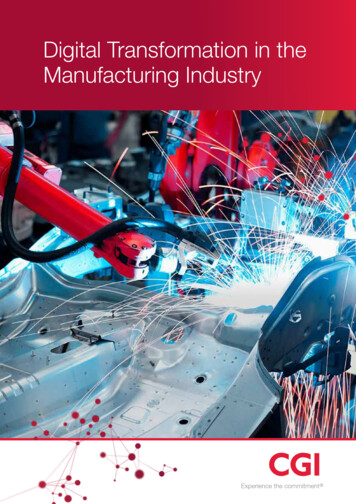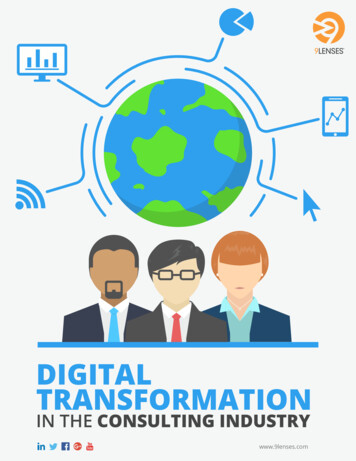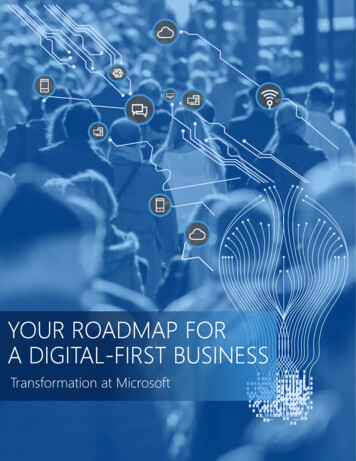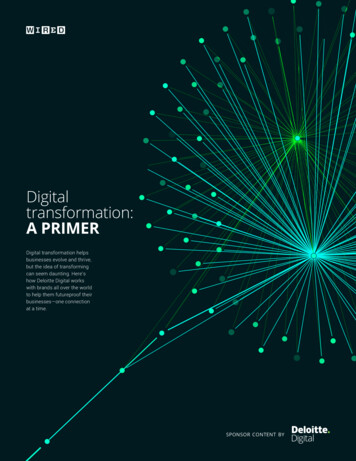
Transcription
Digital Transformation in theManufacturing Industry
Table of ContentsIntroduction03Manufacturers are on the threshold of a new digital era04A digitally-integrated and intelligent value chain is vital to driveinnovation and become customer-centric06The rise of industry platforms08Discrete digital implementations will require enterprise-gradeservice levels10IT modernization will “fuel” digital transformation12Data and analytics is power in the digital world. But what aboutmaster data?13The importance of change leadership14Accelerating the journey: key takeaways152 Point of view: Digital Transformation in the Manufacturing Industry
IntroductionThis paper sets out to explore the current challenges of themanufacturing industry, with particular emphasis on the effectsof digitalization on its processes. The paper builds on the 2016edition of CGI Global 1000, an outlook based on in-depth, inperson conversations with over 1,000 senior business and ITleaders, and provides insights and recommendations garneredfrom CGI’s extensive knowledge and experience helping ourclients in the manufacturing industry increase productivity andagility to transform and grow.About the CGI Global 1000In 2016, as part of our annual Voice of Clients program, CGI metface-to-face with more than 1,000 business and IT leaders across10 industries and 20 countries to hear their perspectives on thetrends impacting their organizations and the implications thesetrends have on their business. From the manufacturing industry,we interviewed 87 clients across 13 countries and multipleindustries including mining, metal, pulp & paper, chemicals,automotive, aerospace, high-tech, industrial and products.Point of view: Digital Transformation in the Manufacturing Industry3
Manufacturers are on the threshold of a newdigital eraAs manufacturers embark on their journey to Industry 4.0, they are accelerating digital to optimize, modernize andautomate. Digital Transformation is accelerating across the value chain Reducing costs, improving agility and speed to market are the key business drivers IoT, mobile and cloud solutions are essential for the transformation IT/Legacy modernization is a key enablerSource: CGI Voice of Our Clients (2016)36%62%90%Almostof our clients haveon-going digitalinitiatives, althoughthey are at differentstages in theirtransformationjourneys.4are exploring digitalinitiatives or runningproof of conceptsPoint of view: Digital Transformation in the Manufacturing Industryare executing digitalpilots and programs,however most arediscrete digitalprojects
The question for our clients today isn’t whether or not to get on the “digital” bandwagon, but how to embracethis transformation in a smart way that brings together their short-term and discrete on-going initiatives with theprerequisites for a long-term vision, governance and architecture.This paper will share insights and recommendations on the somewhat disparate, but important elements thatmanufacturers need to consider when planning a digital strategy and implementing comprehensive solutions tosupport their strategy.Point of view: Digital Transformation in the Manufacturing Industry5
A digitally-integrated and intelligent valuechain is vital to drive innovation and becomecustomer-centricThe CGI Global 1000 outlook reveals the specific drivers of digital transformation in the manufacturing industry: Currently, there is still a strong focus on product transformation—from product-centric to services andsolutions—as well as on operations efficiency With the exception perhaps of the Automotive Industry, the focus on consumerization is slightly lower in themanufacturing industry compared to other more consumer-oriented sectors like banking and retail. Consumerand customer-centric initiatives in the manufacturing industry are very often product driven and leveragesystems and methods such as advanced product configurators and mass customization. Technology modernization is of particular importance as the industry has to often contend with three kinds oflegacies—R&D, operations and enterpriseAlong with the three pillars of Industry 4.0—operations, product lifecycle and value chain—digital transformationin the manufacturing industry boils down to three areas that are tied together in an ubiquitous (cloud- and mobileenabled), automated (software defined) and secure way.Intelligent andconnected assets: fortop-to-bottom integrationof operations6Intelligent andconnected products:aimed at adding value toservices and solutionsPoint of view: Digital Transformation in the Manufacturing IndustryIntelligent andconnected value Chains:for collaboration andinnovation within theeco-system of customers,suppliers and partners
Manufacturing companies need to consider thesetransformation areas and articulate (or re-articulate) whatvalue they bring to their business in terms of client valueand differentiation, new business models and growthpotential, and prioritize accordingly.Point of view: Digital Transformation in the Manufacturing Industry7
The rise of industry platformsThe ability to leverage platforms that focus on reuse and commonality, such as modular design systems or, in IT,ERP platforms, is deeply rooted in the manufacturing industry. As manufacturers seek to embrace an enterprisewide approach to digital transformation, the various discrete digital implementations currently in play—many ofwhich are based on diverse technologies and “niche” solutions—will consolidate onto packaged digital platforms.These platforms will likely be industry specific and will focus on industrial equipment and consumer productssuch as home appliances, connected cars, etc. They will take advantage of the global reach, cost benefits andopportunities for innovation that large cloud providers such as AWS, MS Azure and Google offer.As the emphasis on innovation in products and services grows, these platforms will also need to handle andintegrate product and asset-related information over the various stages of the life cycle, from design, productionand sales to service and retirement.Product Lifecycle Management (PLM), manufacturing information systems and IoT will come together, leveragingconnectivity to cover parts of the product or asset life cycle that have so far been overlooked. This development willlie at the heart of the convergence of digital platforms in the manufacturing industry.For affordability reasons, digital solutions for connected products and connected assets will converge within mostmanufacturers (across Development, Production and Maintenance / Services business scenarios).8Point of view: Digital Transformation in the Manufacturing Industry
The ability to seamlessly integrate Development, Production and Maintenance & Services business scenariosshould be a key consideration in the selection of digital solutions and platforms for manufacturers. Among the 300 digital and IoT “platforms” available in the market, the few that support this convergence will be the ones that standout from the crowd.In addition, manufacturers should consider the platforms’ capability to support open standards and industryframeworks emerging from various industry alliances such as Allseen, Thread, Open Interconnect Consortium (OIC),Industrial Internet Consortium (IIC) and oneM2M. This should be factored in by manufacturers when developingtheir digital strategy and choosing supporting technologies to guarantee future-proof capabilities and consolidateexisting diverse initiatives.Point of view: Digital Transformation in the Manufacturing Industry9
Discrete digital implementations will requireenterprise-grade service levelsMost digital solutions are either business critical (connected assets) and/or client-facing solutions implemented atmanufacturers’ clients’ sites (connected products).A large number of discrete digital implementations today are point solutions that have been implemented byindividual business units in the company. Sometimes provided “as-a-Service”, these discrete projects do nottake into account (at least not at the beginning) integrating the solution with the rest of the company’s portfolio oftechnologies and IT delivery services (Dev-Ops).Critical and/or client-facing solutions require high availability and secure technology. Manufacturers need to keep inmind that the overall reliability of a solution often depends on its weakest component.Right from the beginning, manufacturers need to takea holistic view on the future operability of their digitalsolutions.Strong Software and Applications Lifecycle Management (S&ALM) capabilities will also be required to deploy,update and operate innovative solutions involving a large number of intelligent assets, equipment, devices,appliances, buildings or vehicles. Managing software in an industrialized way has so far not necessarily been apriority for manufacturers. This is changing. The ability to manage software is becoming a core element in theirdigital transformations, and organizations will need to either acquire these competences or rely on partnersfor them. Additionally, manufacturers should also look for strong S&ALM capabilities in the platforms that theyultimately choose as the backbone of their digital initiative.We often hear from our clients the terms of “Mode 1 / Mode 2” and “traditional vs agile IT”. The emergence of a“2-speed IT” is a clear outcome of the CGI Global 1000 survey. This means that the IT organization often managesand runs enterprise and traditional IT environments and projects in parallel, and often separated from, digital andagile initiatives initiated in different business units in the organization, aiming to support their fast changing businessneeds.“2-Speed IT” is a challenge as most manufacturers are often faced with three separate kinds of legacy technologies(R&D IT, Operations IT and Enterprise IT), as a consequence of traditionally siloed cultures.10Point of view: Digital Transformation in the Manufacturing Industry
As enterprise grade service levels are required, the capabilities available in manufacturers’ IT organizations willincreasingly be required for the enablement of digital initiatives: it is in the flexible deployment and operation ofscalable, operationally stable and secure solutions that the two-speed ITs will soon meet, leveraging best of bothworlds. “2-Speed IT” is not a fatality but an opportunity to be embraced by IT organizations.Point of view: Digital Transformation in the Manufacturing Industry11
IT modernization will “fuel” digitaltransformationOf the manufacturing clients interviewed as part of the CGI Global 1000 outlook, 57% cited addressing legacytechnology as the second biggest barrier to digital transformation.Increasing agility and speed of action, guaranteeing operational stability (“Silent IT”) and coping with continuouslyincreasing regulatory constraints while reducing operating costs, is the new equation many manufacturing industryCIOs have to solve. In some companies, finding the answer to this equation is almost a precondition for CIOs to beable to “sit at the digital table” with their business counterparts.In fact, reducing the costs of running the business, in order to invest in transformation and generate growth is acollective theme that emerged from conversations with the CIOs who participated in the CGI Global 1000 outlook. 68% of our clients plan to increase their total IT budgets or keep them flat in the coming years. This is primarilybeing driven by increased analytics capabilities and the need to develop new products and services. 72%, on the other hand, indicate they face significant pressures to contain operational expenditure (OpEx)budgets, and struggle to change their spend mix to fund transformation67% plan to increase or maintainTotal IT Budgets . however organizations have notbeen able to change the mix to fundtransformationAccordingly, the key drivers for the yearover-year trends are:IT modernization/rationalization and transformationaloutsourcing will remain among the top two enablersto achieve “run” costs reductions and “fuel” digitaltransformation.12Point of view: Digital Transformation in the Manufacturing Industry
Data and analytics is power in the digital world.But what about master data?A significant part of the value related to digital transformation relies on manufacturers’ capability to consolidate,analyze and make decision based on real-time information acquired from intelligent and connected things. However,many organizations report that their employees spend a significant part of their time reconciling inconsistentinformation sources, with inconsistent master data related to products, customers, partners, assets, warehouses,etc., often being the root cause of these issues.Major process interruptions or delays often occur due to master data inconsistencies. For example, discrepanciesbetween a bill of materials across sales, production and after sales can result in delayed or wrong shipments, adelay in equipment installations and an increase in working capital; it can even cause low first-time resolution ratesin the service space.The impact of such inconsistencies is exponential in a global digital context with increased levels of automationand speed. This challenge is not new, but it is beginning to get harder. In fact, the axiom, GIGO or garbage in,garbage out, which suggests that the quality of input will determine the quality of output, is truer than ever today.Manufacturers’ capability to govern, maintain and distribute/publish master data will account for a large part of theagility and responsiveness of their end-to-end digitally-enabled business.Master data governance, management and integration are a set of key capabilities that need to be consideredat the outset of charting a digital transformation strategy and roadmap. Supporting solutions, including ProductInformation Management (PIM), Master Data Management (MDM) and Digital Assets Management (DAM) are keycomponents of the backbone platforms that are required now and in the years to come.Point of view: Digital Transformation in the Manufacturing Industry13
The importance of change leadershipof our manufacturing clients interviewedrevealed that managing change andovercoming internal resistance is the mainbarrier to digital transformation.While embedding a digital-first culture is a challenge common to many industries, there are certain distinct culturalcharacteristics of the manufacturing industry that make addressing this challenge unique: Many manufacturing companies, in line with a traditionally product-oriented culture, often focus on theoperational or technical side of things, overlooking the “softer” aspects of change Manufacturers are by nature slightly risk aversive. Changes need to be tested and proven before they can beimplemented and accepting failure is not always a part of the working culture. Change requires stepping out of one’s “comfort zone”, which in the case of manufacturers translates to theneed for thinking beyond a well-established set of processes. The existence of NIH or the “Not Invented Here”syndrome, well-known in engineering-proud cultures can definitely impede rapid changeManaging change is often seen as a set of tactical tools, measures and practices that are needed to fororganizational alignment across R&D, operations and enterprise business functions, under the crucial support andsponsorship from company executives. While these practices are valid as a reference framework, the nature of thechange manufacturers are facing with digital transformation is different: Digital transformation has already started and it is accelerating Manufacturers are in part subjected to it by external factors (consumerization, etc.), which they do not havecontrol over14Point of view: Digital Transformation in the Manufacturing Industry
The goal is a constantly moving and evolving target, making it hard for employees to articulate and understand,which generates a sense uncertainty While structured change management practices have in the past been used during large transformationprograms, they have their limitations today; change must be visible quickly to keep pace with the demands ofa millennial generationChange needs to be embedded in the companyculture to enable “micro-level changes” at the individuallevel. In periods of instability, individuals look forempathic role models whom they can trust to navigateuncertainty and foster a sense of well-being and prideof accomplishment. Enabling these role models in theorganization is what change leadership is about.Accelerating the journey: key takeaways Try to keep it simple and ask, re-ask and ask again the question “why?” “Think big, start small” is a common expression in transformation agendas, and for goodreason. Many manufacturers have started small but now it’s time to take a holistic viewand consolidate the various initiatives on an enterprise-wide basis. Think beyond the cool solution or the trendy app. Manufacturers need to keep the bigpicture in mind when choosing and deploying digital solutions. Reusability, scalability andenterprise-grade operational capabilities, supported by a platform-based approach is theway forward. Look at “2-Speed IT” not as a fatality but as an opportunity, to be addressed by the ITorganization End-to-end master data management is key to digital transformation and cannot beconsidered a by-product any longer Enabling change leadership will play a pivotal role in achieving a successfultransformation to digitalPoint of view: Digital Transformation in the Manufacturing Industry15
www.cgi.comAbout CGIFounded in 1976, CGI is one of the largest, end-to-end IT and business processservices providers in the world. Operating in hundreds of communities across theglobe, we help clients become customer-centric, digital organizations. Our high-endbusiness and IT consulting, systems integration and transformational outsourcingservices, complemented by more than 150 IP-based solutions, help clients acceleratetheir digital strategies. Our unique client proximity and best-fit global delivery modelenables highly responsive service, on-time and within budget delivery, and competitiveadvantage for an increasingly digital world. We are one of the few providers with thetalent, scale and end-to-end capabilities that clients need to connect legacy to digitalfor holistic success.For more information about CGI, visit www.cgi.se and info.se@cgi.com. 2017 CGI GROUP INC.
Point of view: Digital Transformation in the Manufacturing Industry Digital Transformation is accelerating across the value chain Reducing costs, improving agility and speed to market are the key business drivers IoT, mobile and cloud solutions are essential for the transform










